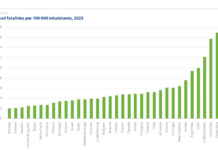Two-wheelers — mopeds, motorcycles, and other higher-speed, high-powered motorbikes — are gaining in popularity, especially the faster ones. They are quick and affordable, and must be electrified, but they can also cause a lot of harm on the street. Because two-wheelers are often small, cheap, and fast, they are reasonably well-suited to congested urban environments. In cities with few good options, more and more people depend on two-wheelers to meet basic transport needs. In places like India and Indonesia, two-wheelers comprise the overwhelming majority of registered vehicles (72% and 83% respectively). While this has improved access to jobs, education, and services, especially for low-income people, the negative impacts on both individual users and society are continuing to grow. The characteristics that make two-wheelers so popular (being small and quick) make them deadly to riders and those around them, especially on streets that lack separated spaces for pedestrians and cyclists. And this issue is getting worse. Injuries and deaths from two-wheelers are soaring and recently surpassed deaths from passenger cars for the first time.
The post Are Electric Two-Wheelers the Future? first appeared on Institute for Transportation and Development Policy.









